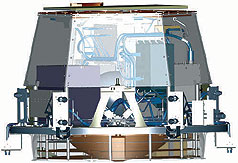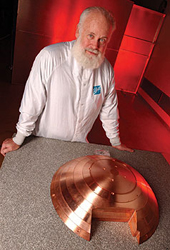Copper to Reveal Comet’s Makeup
 Drawing detail of Impactor module with copper mass that will plunge into the Tempel 1 comet on July 4, 2005.
Drawing detail of Impactor module with copper mass that will plunge into the Tempel 1 comet on July 4, 2005.What comets are made of will be revealed this coming Fourth of July by unique fireworks — the collision between the copper "impactor" part of NASA's "Deep Impact" spacecraft and the comet "Tempel 1." The impactor’s key component is 770 pounds of solid copper.
Its violent impact on the comet is expected to create a crater as big as a football field and as deep as a seven story building. A camera and infrared spectrometer on the spacecraft, along with ground based observatories, will study the resulting icy debris blasted off the comet, as well as the pristine interior material exposed by the impact. The spectrographic analytical instruments should reveal what comets, among the oldest objects in the solar system, are made of.
 Dr. Michael F. A’Hearn, University of Maryland astronomer, with the Deep Impact copper cratering mass.
Dr. Michael F. A’Hearn, University of Maryland astronomer, with the Deep Impact copper cratering mass.Although the violent collision takes place 80 million miles from Earth, the impact will be visible to those with telescopes. (The impact will be televised for those without telescopes.) Deep Impact was launched in January of this year.
Why is the impactor made of copper? Because when copper burns — which it will from the enormous force of the impact — it is less likely than other metals to create bright, confusing emission lines in the spectrum of interest, according to Dr. Michael F. A'Hearn, Deep Impact principle investigator, Department of Astronomy, University of Maryland at College Park.
NASA:
845-457-1992;
Jet Propulsion Laboratory
Also in this Issue:
- Heavenly Copper
- Copper Could Help Counter Health Crisis
- Lady Liberty Provided Copper for Chopper
- Copper to Reveal Comet’s Makeup
- Motor Swaps Save Big
